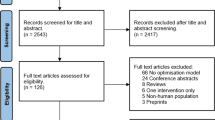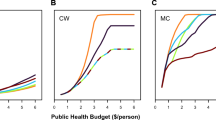Abstract
Vector control, particularly distribution of insecticide-treated bed nets (ITNs), constitutes one of the major pathways to prevent and reduce malaria transmission. ITN distribution campaigns face several challenges, such as inadequate funding, budgetary constraints, hard-to-reach areas, limited transportation, and market and price volatility. While long-term agreements and proper planning can effectively overcome such challenges, those options may not be available for all humanitarian organizations and governments. To gain a better understanding of such tradeoffs we develop a robust optimization model that minimize ITN distribution costs while taking into consideration protection against financial, market and logistical uncertainties. The simultaneous account of such uncertainties is rarely seen on the humanitarian supply chain design literature. The proposed robust model explores data-driven adaptive uncertainty sets that capture the dependence structure among procurement and distribution costs, leading to plausible uncertain scenarios. In addition, we develop a hierarchical optimization approach to ease the burden of setting a specific robustness level for each constraint, when uncertainties are related to the independent terms. We study a United Nations Children’s Fund ITN distribution campaign in Ivory Coast, observing that (1) total costs increase with campaign robustness, as expected, and (2) campaign robustness comprises of improved supply chain flexibility, which might minimize efforts if it becomes necessary to adjust procurement and transportation plans when uncertainty arises. In addition, assessing robust solutions through Monte Carlo simulations against several realizations of uncertain parameter values indicates that, as desired, robust plan feasibility increases with the specified level of conservatism.




Source: Adapted from Brito et al. (2014)

(adapted from Brito et al. 2014)








Source: Author
Similar content being viewed by others
References
Alvarez-Miranda, E., Fernandez, E., & Ljubic, I. (2015). The recoverable robust facility location problem. Transportation Research Part B-Methodological,79, 93–120.
Ben-Tal, A., & Nemirovski, A. (1998). Robust convex optimization. Mathematics of Operations Research.,23, 769–805.
Ben-Tal, A., & Nemirovski, A. (2000). Robust solutions of linear programming problems contaminated with uncertain data. Mathematical programming. A,88, 411–424.
Bertsimas, D., & Sim, M. (2004). The price of robustness. Operations Research,52(1), 35–53.
Bertsimas, D., Thiele, A. (2006a) Robust and data-driven optimization: modern decision making under uncertainty. In: Models, Methods, and Applications for Innovative Decision Making. INFORMS. p. 95-122
Bertsimas, D., & Thiele, A. (2006b). Robust optimization approach to inventory theory. Operations Research,54, 150–168.
Bozorgi-Amiri, A., Jabalameli, M. S., & Al-E-Hashem, S. M. J. M. (2013). A multi-objective robust stochastic programming model for disaster relief logistics under uncertainty. OR Spectrum,35(4), 905–933.
Brito Jr, I., Uneddu, S., Goncalves, P. (2014). Supply chain optimization of the distribution of mosquito nets in Ivory Coast. In 25th annual POMS conference—production and operations management society, 2014, Atlanta. Anais do 25th annual POMS conference, 2014.
Catholic Relief Services (CRS). (2014). In-country management and distribution of long lasting insecticide-treated nets: A logistics guide for implementers. Available at http://www.crs.org/our-work-overseas/research-publications/country-management-and-distribution-long-lasting-insecticide. Site visited on August 15, 2016.
Caunhye, A. M., Nie, X., & Pokharel, S. (2012). Optimization models in emergency logistics: A literature review. Socio-Economic Planning Sciences,46(1), 4–13.
Das, R., & Hanaoka, S. (2013). Robust network design demand uncertainty in humanitarian logistics. Journal of the Eastern Asia Society for Transportation Studies,10, 954–969.
Fernandes, B., Street, A., Valladao, D., & Fernandes, C. (2016). An adaptive robust portfolio optimization model with loss constraints based on data-driven polyhedral uncertainty sets. European Journal of Operational Research,255(3), 961–970.
Florez, J. V., Lauras, M., Okongwu, U., & Dupont, L. (2015). A decision support system for robust humanitarian facility location. Engineering Applications of Artificial Intelligence,46(Part B), 326–335.
Galindo, G., & Batta, R. (2013). Review of recent developments in OR/MS research in disaster operations management. European Journal of Operational Research,230(2), 201–211.
Global Fund, World Health Organization, The African Leaders Malaria Alliance, United Nations Children’s Fund, United States Agency For International Development. (2015). The global fund and UNICEF LLIN suppliers meeting. Available at https://www.unicef.org/supply/files/P4I_2015-09-15-GlobalFundUnicefLLINSuppliersMeeting_Presentations_en.pdf. Site visited on August 15, 2016
Goes, G., Oliveira, F. (2015). Pre-positioning and distribution of emergency supply items considering network resilience: A robust optimization approach. In SBPO 2015—XLVII Simpósio Brasileiro de Pesquisa Operacional, 2015, Porto de Galinhas, PE. Anais do SBPO 2015—XLVII Simpósio Brasileiro de Pesquisa Operacional, 2015.
Hoyos, M. C., Morales, R. S., & Akhavan-Tabatabaei, R. (2015). OR models with stochastic components in disaster operations management: A literature survey. Computers & Industrial Engineering,82, 183.
Index mundi. (2017). Crude oil brent prices. Available at http://www.indexmundi.com/commodities/?commodity=crude-oil-brent&months=300. Site visited on January 10, 2017.
Investing. (2017a). Dry baltic index. Available at https://www.investing.com/indices/baltic-dry. Site visited on 10 January 2017.
Investing. (2017b). US steel coil futures. Available at https://www.investing.com/commodities/us-steel-coil-futures. Site visited on January 10, 2017.
Jabbarzadeh, A., Fahimnia, B., & Seuring, S. (2014). Dynamic supply chain network design for the supply of blood in disasters: A robust model with real world application. Transportation Research Part E-Logistics and Transportation Review,70, 225–244.
Keshvari Fard, M., Eftekhar, M., Papier, F. (2017). A policy for managing operational assets to minimize deprivation costs. Working paper, available at SSRN https://ssrn.com/abstract=2893125. Accessed 26 Apr.
Leiras, A., Brito, I., Jr., Bertazzo, T. R., Peres, E. Q., & Yoshizaki, H. T. Y. (2014). Literature review of humanitarian logistics and disaster relief operations research. JHLSCM - Journal of Humanitarian Logistics and Supply Chain Management,4(1), 95–130.
Logistics Cluster. (2017). Cote D’Ivoire port assessment. Available at http://dlca.logcluster.org/display/public/DLCA/2.1+Cote+D%27Ivoire+Port+Assessmenta. Site visited on March 2, 2017.
Malaria Consortium. (2016). Long lasting insecticidal nets. Available at http://www.malariaconsortium.org/pioneer/pages/what-we-do/long-lasting-insecticidal-nets/. Site visited on August 15, 2016.
Najafi, M., Eshghi, K., & Dullaert, W. (2013). A multi-objective robust optimization model for logistics planning in the earthquake response phase. Transportation Research Part E-Logistics and Transportation Review,49(1), 217–249.
Natarajan, K. V., & Swaminathan, J. M. (2014). Inventory management in humanitarian operations: Impact of amount, schedule, and uncertainty in funding. Manufacturing & Service Operations Management,16(4), 595–603.
Net Mapping Project. (2016). Quarterly reports 2015. Available at http://allianceformalariaprevention.com/working-groups/net-mapping-project/. Site visited on August 15, 2016.
Paul, J. A., & Hariharan, G. (2012). Location-allocation planning of stockpiles for effective disaster mitigation. Annals of Operations Research,196(1), 469–490.
Rezaei-Malek, M., Tavakkoli-Moghaddam, R., Zahiri, B., & Bozorgi-Amiri, A. (2016). An interactive approach for designing a robust disaster relief logistics network with perishable commodities. Computers & Industrial Engineering,94, 201–215.
Roll Back Malaria. (2011). Country to country guide for LLIN keep‐up: A guide for continuous delivery of LLINs via ANC, EPI, and other routine health services. Available at http://www.rollbackmalaria.org/files/files/partnership/wg/wg_itn/docs/ws3/4-LLIN_Keep_Up_Guide.pdf. Site visited on August 15, 2016.
Rottkemper, B., Fischer, K., & Blecken, A. (2011). A transshipment model for distribution and inventory relocation under uncertainty in humanitarian operations. Socio-Economic Planning Sciences,45, 132–145.
Soyster, A. L. (1973). Convex programming with set-inclusive constraints and applications to inexact linear programming. Operations Research,21, 1154–1157.
Tang, F., Zhang, L., Huang, J., Yang, W. (2009). An affinely adjustable robust optimization approach to emergency logistics distribution under uncertain demands. In Proceedings of industrial engineering and engineering management conference (pp. 1738–1742). IEEM, IEEE.
Thanopoulou, H., & Strandenes, S. P. (2017). A theoretical framework for analysing long-term uncertainty in shipping. Case Studies on Transport Policy,5(2), 325–331.
Toni, A., & Tonchia, S. (2005). Definitions and linkages between operational and strategic flexibilities. Omega,33(6), 525–540.
United Nations (UN). (2017). Sustainable development goals. Available at http://www.un.org/sustainabledevelopment/sustainable-development-goals/. Site visited on January 10, 2017.
United Nations Children’s Fund (UNICEF). (2016). Long-lasting insecticidal nets supply update 2016—UNICEF Supply Division. Available at https://www.unicef.org/supply/files/LLIN_Supply_Status_-_August_2016.pdf. Site visited on August 18, 2016.
United States Agency for International Development (USAID). (2010). LLIN market and data analysis. Cost effectiveness study—final report. Available at http://deliver.jsi.com/dlvr_content/resources/allpubs/guidelines/LLINMarkData.pdf. Site visited on August 18, 2016.
United States Energy Information Administration (USEIA). (2017). Weekly retail gasoline and diesel prices. Available at https://www.eia.gov/dnav/pet/PET_PRI_GND_DCUS_NUS_M.htm. Site visited on 10 January 2017.
WHO. (2015). World malaria report 2015. Available at http://www.who.int/malaria/publications/world-malaria-report-2015/report/en/. Site visited on August 15, 2016.
WHO. (2016a). Malaria fact sheet. Available at http://www.who.int/mediacentre/factsheets/fs094/en/. Site visited on August 15, 2016.
WHO. (2016b). WHO recommended long-lasting insecticidal nets 1 April 2016. Available at http://www.who.int/whopes/Long-lasting_insecticidal_nets_April_2016.pdf?ua=1. Site visited on August 15, 2016.
World Health Organization (WHO). (2014). Estimating population access to ITNs versus quantifying for procurement for mass campaigns. Available at http://www.who.int/malaria/publications/atoz/who-clarification-estimating-population-access-itn-mar2014.pdf. Site visited on August 18, 2016.
Zokaee, S., Bozorgi-Amiri, A., & Sadjadi, S. (2016). A robust optimization model for humanitarian relief chain design under uncertainty. Applied Mathematical Modelling,40(17–18), 7996–8016.
Author information
Authors and Affiliations
Corresponding author
Appendix
Appendix
1.1 Model sets, parameters and variables
See Table 4.
Rights and permissions
About this article
Cite this article
Gomes de Mattos, R., Oliveira, F., Leiras, A. et al. Robust optimization of the insecticide-treated bed nets procurement and distribution planning under uncertainty for malaria prevention and control. Ann Oper Res 283, 1045–1078 (2019). https://doi.org/10.1007/s10479-018-3015-8
Published:
Issue Date:
DOI: https://doi.org/10.1007/s10479-018-3015-8




